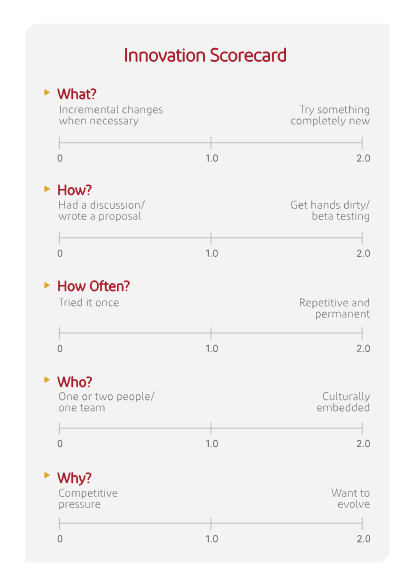What Is Your Innovation Rating?
By Jodie Baker
Innovation is such an over-used term in legal circles today that it is becoming difficult to respect the commentary, or wade through the noise and find real examples of stand-out innovation, something to be emulated or inspired by.
It can be exciting to see so many organisations – both firms and corporates – developing new ways to address traditional problems, and yet at times it feels like little more than a race to the ‘innovation finish line’ with everybody trying to out-do one another with the latest app, legal process outsourcing or flexible working policy.
When everybody is doing it, is it really innovation? Or is everybody in the legal landscape running hard just to stand still?
Who has a right to call themselves ‘innovative’ in this noisy landscape? Some ‘innovations’ will deliver nothing more than a place at the table, the right to keep playing, Others will dramatically change the competitive advantage delivered to one firm over another. How can you tell one sort of innovation from another?
Organisation’s Innovation Rating
It is time to genuinely give your organisation an innovation rating based on the following five measures (each scored out of 2.0):
- What is it that you are doing that is innovative? Are you trying something new, something you have never done before? Are you adopting significant changes in systems or processes to develop new ways of doing old things? Or are you seeking incremental change by adopting minor improvements to your existing business? Perhaps you are doing nothing at all, and are content with your current processes?
- How are you doing it? Did you have a discussion and write a proposal, but then did nothing more because the risk was too high? Or are you making investments? Testing technologies when still in beta? Are you prepared to accept failure in the quest for finding better solutions?
- How much or how often are you trying new things? Are you checking a box, trying it once so that you can tell your clients, your staff, perhaps even yourself that you have an innovation program? Or are you genuinely changing your work practices in a repetitive and permanent fashion?
- Who is given permiss ion to try new things? A dedicated team? Senior members or junior ‘tech savvy’ members of your team only? At what level is change being generated. Are individuals driving change or is the organisation itself promoting an environment that fosters innovation?
- Why are you undertaking these innovative projects? Are you scared by what your competitors are doing? Or do you want to explore and evolve, to genuinely become something new and different to what you are today?

At one end of the spectrum we have organisations who are doing little more than a box-ticking exercise, engaging in ‘Innovation Theatre’, and at the other, organisations who create an environment for new ideas to flourish, with support to implement these ideas culturally engrained at every level.
Market’s Innovation Rating
Now consider the context of your Organisation’s Innovation Rating.
The Market Innovation Rating is the weighted average of all organisations and firms which operate within it. This is arguably much higher today than 20 years ago, with technology developments and new work practices super charging the legal industry.
We don’t need to spend time pondering the wondrous innovations in the Australian legal landscape by the likes of law firms Gilbert & Tobin, Hive Legal and KWM, corporate legal teams like Boral, Westpac and Virgin Australia or the many and varied members of the Australian Legal Technology Association. All these innovations are well covered by the media.
However, there are laggards, and plenty of them, who cling desperately to the status quo and the mantra “if it ain’t broke, don’t fix it”.
On balance, I consider Australia’s Legal Market Innovation Rating a 7.5 out of 10.
What is your Organisation’s Relative Innovation Rating?
Nothing happens in a vacuum. Your Organisation’s Innovation Rating matters, but it is the Relative Innovation Rating that matters more. The calculation is simple:
Relative Innovation Rating = Organisation’s Innovation Rating less Market’s Innovation Rating
A Relative Innovation Rating less than 0 means your organisation is less innovative than the market, is behind the curve, lagging the broader market, likely to diminish in relevance. While your organisation may improve its productivity with some innovative programs, the market standard will continue to increase. So relatively speaking, you will fall behind.
A Relative Innovation Rating = 0 means your organisation is on the same innovation level as the market. You are not likely to be losing ground, but nor will you surge ahead by virtue of your innovation investments.
A Relative Innovation Rating greater than 0 means your organization is pushing forward and is more innovative than most participants in the legal industry. Assuming successful innovative strategies are implemented, your organisation is likely to differentiate itself with market leading programs.
What Relative Innovation Rating should you be striving for?
In today’s market, the highest relative innovation rating an organisation can achieve is 2.5, which puts it at the highest end on the organization innovative scorecard. Here, an organisation is taking risks – big risks – to push ahead of the market. That level of risk is not for everybody, and why we will continue to see big shifts in market power within the legal industry over the coming decade.
About the Author
Jodie Baker is the Founder & CEO of Xakia Technologies and Co-Chair of the Advisory Board for the College of Law's Centre for Legal Innovation. Jodie has a background in law, financial services and innovation and has two start-ups to her name - Hive Legal and Xakia Technologies. Jodie is particularly passionate about legal tech and legal data analytics, and is dedicated to making legal innovation accessible and easily adopted by all lawyers.
Jodie can be contacted at:
Email: jodie.baker@xakiatech.com
Linked In: https://www.linkedin.com/in/jodiebakerxakia/
Twitter: @jodiebaker74
This blog post is an adaptation from the keynote speech given by Jodie at the launch of the Victorian chapter of The Legal Forecast, and is published here with the kind permission of The Legal Forecast.

